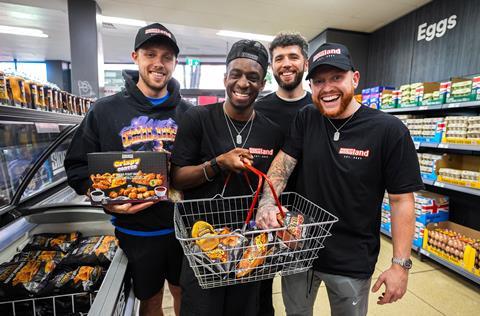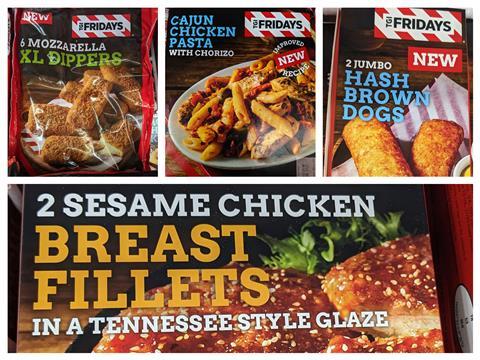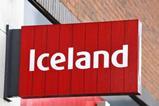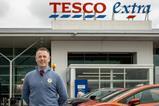Richard Walker is in a triumphant mood as sales rise thanks to price freezes, partnerships and NPD. Can Iceland maintain the momentum?
Iceland Food executive director Richard Walker was buoyant following the retailer’s annual update to bondholders last week, declaring it to be in “the best financial health it’s ever been”.
Walker gleefully shared Kantar data showing volume sales across Iceland and the Food Warehouse grew 7.9% in the 12 weeks to 7 July, the fastest rate across the mults by some way (see below). Value sales grew 4.1% over the same period, ahead of the market’s 2%.
The claims of financial health were backed up by accounts later published at Companies House. Iceland posted pre-tax profits of £15.6m in the year to 29 March 2024, a reverse of a £16.2m loss during the same period last year. Turnover rose 6.5% to £4.1bn.
That growth looks even more impressive when considered that it’s been achieved, as Iceland pointed out, “without the traditional boost from net new store openings”. Iceland’s footprint fell overall by 29 stores, to 790 overall.
So, what is Iceland getting right? What’s bringing customers back to its stores? And what does it need to do to maintain that growth?
Strategy paying off
There’s no doubt Iceland’s growth partly reflects a natural bounceback following efforts to curb its energy costs and rationalise its stores over the past two years. But the turnaround also stems back to a new strategy developed at the start of 2023.
The first move was on value. In January 2023, Iceland extended a price freeze on its £1 or Less Range, pledging to hold prices on more than 600 lines until the end of the year.
At the same time, it’s been expanding its lineup. Additions include fresh, ambient and household products, on top of the core frozen lines.
It has also complemented the value tier investment with a new multibuy price mechanism. ‘Mix and Match’ promotions – like ‘5 for £5’ and ‘3 for £10’ – have become a key fixture of its stores. One standout deal involved offering shoppers the chance to buy 10 Birds Eye products for a tenner.
“The multibuy offers have been pretty impactful,” says IGD’s Bryan Roberts. “Throw in other initiatives like the hugely successful discount day for seniors, and it’s little surprise that they seem to be motoring.”

The other major focus of the strategy has been innovation. Within and outside the business, this is perceived as Iceland’s key strategic advantage over other frozen rivals.
A crucial part of that strategy has been growing its programme of exclusive brands.
Iceland has built partnerships with the likes of Greggs, TGI Fridays and more recently YouTube group Sidemen, to launch high-profile exclusive ranges into its stores.
The launch of its Brands on Ice accelerator scheme in July, also aimed at launching exclusive products, has already seen the likes of Jamie Oliver, Müller and Happy Egg Co sign up.
“Very few other retailers are doing brand collaborations in the way Iceland is,” says PwC senior retailer advisor Kien Tan. “Iceland has turned it into an art form. They’ve brought excitement back into a category that they own.”
While brands have been the highest-profile additions, the innovation drive has also extended to own label. More than 1,000 SKUs have been added in the past financial year, Iceland said in the results. Those include a new ‘fakeaway’ Grill House range and additions to its top-tier Luxury range.
Plus, in October 2023, Iceland relaunched its entire fruit & veg category, in partnership with Irish supplier Keeling’s. That was followed in April with the launch of a new own-label household range, ‘Home’.

Point of difference
By focusing on innovation across all its lines, Iceland has gained a key point of difference to other discounters, Tan says.
“There’s a little bit of trading up, which you can’t do in any of the other frozen specialists.”
Collectively, the strategy means Iceland is reaping the rewards from a falling rate of food inflation. This comes at a time when, as Shore Capital’s Clive Black notes, many of its rivals are “off the boil”.
“Iceland’s store standards tend to be consistently high,” Black says. “It knows its customer base well, it has sussed out its private label assortment to give it authority and exclusivity against the value end of the market.”
The recent success has not gone unnoticed. Amid its own strategic reset, Asda has poached senior Iceland figures. First is buying director Andrew Staniland, who starts a new VP role in March. He’ll join David Devany, who’s been made Asda VP for e-commerce. So far, Iceland has no plans to replace them, but their loss will be a big blow to its leadership.

A debt ratio of more than four times its equity remains another challenge, even if the improved performance was enough for Moody’s to upgrade its credit rating from a B3 to a B2.
However, the agency pointed to Iceland’s network of “well-located” and majority profitable stores as a significant opportunity. And in July, the company began a search for 250 sites for its Food Warehouse format, which now forms the main thrust of its store rollout.
“Food Warehouse is providing store growth that draws upon the core offer but also attracts a wider shopper base, where bigger ticket, deals, and larger pack size can be explored,” Black says.
Further chances for growth lie in the extension of its concessions with The Range – now present in 119 stores – as well as the rollout of its third-party supply with Amazon.
Now Iceland has attracted more shoppers to stores, the challenge is to get them to spend more – as shown by its value market share barely moving at 2.3% [Kantar].
Many customers still don’t see Iceland as a destination for a full basket shop, Tan highlights.
“They’ve done well to ride the ups and downs. Now they’ve got to keep going.”

Stephen is The Grocer’s senior retail reporter. He leads our coverage of Sainsbury’s, Waitrose and Iceland as well as retailers including Booths Holland & Barrett, Whole Foods Market and Hotel Chocolat. Prior to joining The Grocer in December 2022, he was transportation reporter at Business Insider, where he covered the global operations of major automakers, airlines and global shipping. He first joined Insider in July 2021 as a careers reporter. Before that he spent three years covering business, retail, and leadership for Management Today and spent a short period as a match day reporter for the Non-League paper.
View full Profile























No comments yet